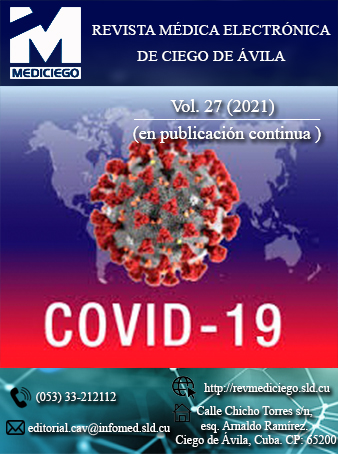Epidemiological and clinical characteristics in patients with nonvalvular atrial fibrillation
Abstract
Introduction: atrial fibrillation is the arrhythmia that occurs most frequently in clinical practice, it is the cause of high hospitalization and requires adequate anticoagulant treatment.
Objective: to describe some of the demographic, epidemiological and clinical characteristics of patients with nonvalvular atrial fibrillation.
Methods: a cross-sectional study was carried out in patients admitted to the General Provincial Teaching Hospital of Ciego de Ávila during the three-year period January/2015-December/2017. The study included 194 patients who met the inclusion criteria. Data were collected from medical records. The CHA2DS2-VASc and HAS-BLED scales were used to assess thromboembolic and bleeding risk. The ethical principles were fulfilled.
Results: the male sex predominated (54.12 %), the age group between 51 and 75 years in both sexes (13.92 %, male and 11.86 %, female), arterial hypertension as a risk factor (73,20 %) and permanent atrial fibrillation as typology (67.53 %). Just over half had criteria for anticoagulation (55.67 %) and about a third (33.51%) had an increased risk of bleeding. Only 20.10 % had an anticoagulant prescription.
Conclusions: the male sex predominated, between 51 and 60 years old, with arterial hypertension as a risk factor and the permanent typology of atrial fibrillation, with criteria for anticoagulant treatment that had not prescribed it yetDownloads
Published
How to Cite
Issue
Section
License
Those authors who have publications with this journal accept the following terms of the License CC Attribution-NonCommercial 4.0 International (CC BY-NC 4.0):
You are free to:
- Share — copy and redistribute the material in any medium or format for any purpose, even commercially.
- Adapt — remix, transform, and build upon the material for any purpose, even commercially.
The licensor cannot revoke these freedoms as long as you follow the license terms.
Under the following terms:
- Attribution — You must give appropriate credit , provide a link to the license, and indicate if changes were made . You may do so in any reasonable manner, but not in any way that suggests the licensor endorses you or your use
- No additional restrictions — You may not apply legal terms or technological measures that legally restrict others from doing anything the license permits.
The journal is not responsible for the opinions and concepts expressed in the works, which are the exclusive responsibility of the authors. The Editor, with the assistance of the Editorial Committee, reserves the right to suggest or request advisable or necessary modifications. Original scientific works are accepted for publication, as are the results of research of interest that have not been published or sent to another journal for the same purpose.
The mention of trademarks of specific equipment, instruments or materials is for identification purposes, and there is no promotional commitment in relation to them, neither by the authors nor by the editor.






















